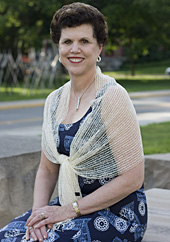AMES, Iowa -- The Obama administration has invested $12 billion in community colleges to provide greater higher education access to all Americans as a way to revitalize the nation's economy. And research by Linda Serra Hagedorn, a professor of educational leadership and policy studies and director of Iowa State University's Research Institute for Studies in Education (RISE), has shown the value community colleges play in the educational success of students.
But Hagedorn, the author of the chapter "The pursuit of student success: The directions and challenges facing community colleges" in the annual edition of "Higher Education: Handbook of Theory and Research," also warns community college officials to proceed with caution as they may use new money to expand their degree options and provide the new applied baccalaureate degrees.
"If not handled cautiously, the attempt to expand degree options could have negative effects on the community colleges' abilities to support the programs and activities designed for students needing special assistance," she wrote. "The future will determine if the new baccalaureates will widen the path for the pursuit of success or will provide opportunities selectively, thus constricting the path of others."
For her chapter, Hagedorn analyzed national data on community
college student success, retention and transfer. She made the
following policy suggestions on how community colleges could
become more effective in their postsecondary education
role:
1. Increase involvement between two- and four-year
institutions by way of state level meetings, faculty
development and other venues as appropriate. "In
the era of budget cuts, it may make economic sense to combine
faculty development efforts for faculty employed in state
institutions," Hagedorn wrote. "Separate is usually
not equal. Further, meeting colleagues at other institutions in
the same or similar disciplines may have positive curricular
effects for all."
2. Two- and four-year colleges may benefit from joint strategic planning -- especially among colleges that share articulation agreements. "It's surprising that some states' university and community college presidents do not have regular meetings or co-consult in decision making," she wrote. "Bringing together the upper administration from both two- and four-year state colleges in a regular schedule to discuss current policies may help to bridge the two entities."
3. Shared Facilities. "Brick and mortar are becoming increasingly expensive and desperately sought," she wrote. "While it may be that neither community colleges nor the four-year has excess space to spare or share, in some instances, facilities may be used in a different pattern. For example, some universities may not utilize all of their classroom space in the late evening hours or over the weekend; times that are especially crushed for community colleges. In such cases, establishing a shared environment may be mutually beneficial for colleges within reasonable driving distances."
4. Sharing of technology. "Among the two- and four-year sectors, distance education is growing at a very quick pace. Yet establishing and maintaining the technology structures can be very expensive," wrote Hagedorn. "Setting up a system that includes community and state colleges may be a possible venue for promoting cost efficiency."
5. Transfer policy redo. "With increasing numbers of students electing to begin their postsecondary experience at a community college, it may serve universities well to have a process in place that allows them to better plan for transfers," she wrote. "A procedure that is gaining momentum is extending future acceptance to first-year students by clearly stating that their acceptance is contingent upon the successful completion of a certain number of credits at a state community college. Universities may also consider allowing community college students within commuting distance to take a limited set of courses direct from the university while still enrolled at the community college. It will be the understanding that these credits will apply to the baccalaureate as well as to the associate's degree. For others, universities may consider this type of dual enrollment to be offered via distance mode."
6. Transfer student scholarships. "Since many students who begin their postsecondary journeys at a community college are in lower socio-economic brackets, even small scholarships may prove helpful," she wrote. "Such scholarships may extend beyond the financial assistance and provide evidence of welcome and acknowledgement."
7. Reverse transfer. "When university students leave their [four-year] institution and attend a community college, the act is typically viewed with a level of disgrace. For many students, this act is one of a search for a better fit," wrote Hagedorn. "Articulation agreements are almost exclusively written from the perspective of one-way travel. Hence calculating credits from the four-year to apply to an associate's degree or certificate is like navigating in unchartered waters. In an era of increasing flow from the four- to the two- year institution, policies recognizing reverse credit flow may be helpful for students and for institutions."
Hagedorn is the president-elect of the Association for the
Study of Higher Education. She and Larry Ebbers, a University
Professor in educational leadership and policy studies and head
of ISU's Community College Leadership Program, helped Iowa
State become a research partner with the Academy for
Educational Development and the Education Commission of the
States on a new national Community College Policy Center.
